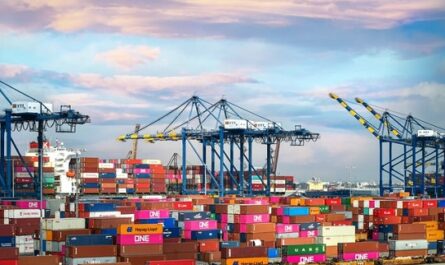System automation has become a hot topic in many industries. Companies are racing to adopt automation technology in the hope of reducing human error and increasing operational efficiency. However, behind the potential benefits lie significant challenges, including system errors.
This article delves into how automation can introduce new risks, especially in the context of Supply Chain Management (SCM), and outlines strategies for effectively managing these risks.
Before we go further into this topic, don’t forget to follow my LinkedIn account. You’ll get more helpful insights on supply chain management there.
Table of Contents
Understanding System Errors: What’s Really Happening?
You may have invested heavily in technology to replace human tasks that are prone to error. However, it’s important to understand that while automated systems can reduce human error, they are not immune to failure. System errors are types of faults that occur within the software or hardware used to automate your business processes.
There are various causes of system errors. One common cause is bugs or faults in the software. Even after extensive testing and release, unexpected errors can still emerge under certain conditions. Hardware failure is another major cause. Imagine if a critical component of your server suddenly fails—this could cause the entire system to halt.
Configuration errors made during system setup can also be a source of problems. These errors might occur due to a lack of knowledge or attention during setup.
Additionally, despite being called system errors, sometimes the root cause is user error in operating the system. For instance, a staff member might accidentally delete important data due to not fully understanding how the system works.
Cyber attacks also present an increasing threat. Malicious actors can damage or take over your system, leading to significant losses. Lastly, network issues, such as unstable connections, can disrupt systems that rely on connectivity. All these factors indicate that while automation can help reduce human error, it introduces new risks that you need to manage carefully.
The Impact of System Errors: More Significant Than You Think
System errors are not to be taken lightly, as their impact can be widespread and detrimental. For example, imagine your operational system suddenly experiences downtime. Business operations could come to a halt, leading to significant financial losses. In businesses that rely on continuous processes, every minute of downtime could mean lost revenue.
Moreover, data loss is a serious consequence of system errors. Data is a critical asset for many companies, particularly in sectors heavily reliant on information such as finance, healthcare, and e-commerce. Losing crucial data can lead to various issues, from service disruptions to legal breaches if the data relates to customer privacy.
Furthermore, system failures can also impact data security and privacy. Data breaches resulting from system errors can be a nightmare for any company. This not only leads to financial losses but also damages your reputation with customers. They may lose trust in your company if they discover that their personal data is not secure.
Therefore, understanding the potential impacts of system errors and preparing effective mitigation strategies is crucial for protecting your business.
You might also like:
- PPIC: The Common Enemy in the World of Manufacturing
- The Importance of Involving Everyone from the Beginning in Supply Chain Projects
Managing System Error Risks: Key Steps
To mitigate the risks associated with system errors, there are several strategic steps you can take.
First, regular testing and maintenance are essential. Routine testing allows you to detect bugs or issues before they become major problems that disrupt operations. For example, you might conduct simulations to see how your system reacts under certain conditions, such as high workload or network disruptions. This way, you can identify potential issues early and take preventive action.
Additionally, system updates should be performed regularly. Software continues to evolve, and updates usually include bug fixes and security improvements. Ignoring updates could mean retaining a system with known vulnerabilities that could be exploited by malicious parties.
Redundancy and backup are crucial components in managing system error risks. By having a robust backup and redundancy system, you can ensure that operations continue even if the primary system fails. For instance, if one server fails, a backup server can take over immediately, minimizing operational disruptions.
Training users is also vital. User errors can trigger system errors, especially if they are not properly trained in using new systems. Ensure your team receives adequate training so they understand how the system works and know what to do if issues arise. You might also consider creating user guides or manuals that are readily accessible to help users resolve minor issues on their own.
Real-time monitoring is another effective risk management strategy. By using monitoring tools, you can detect problems as soon as they arise. For example, if a system begins to show signs of instability, you can take action to prevent further issues. Additionally, having a solid recovery protocol is essential. If a system fails, recovery protocols help restore normal operations as quickly as possible, minimizing negative impacts on business.
Is Automation Just Shifting the Problem?
You might wonder, “Is automation merely shifting problems from human error to system error?” This is a valid question, and the answer is both yes and no. Indeed, by switching to automation, you are shifting risk from human error to system error. However, this does not mean you are free from issues. Automation shifts the focus of risk from human aspects to technological ones.
However, it’s important to remember that automation is not just about shifting problems. It offers opportunities to manage and reduce risks in a more systematic and predictable manner. For example, machines and software do not experience fatigue, so they can work consistently 24/7 without performance degradation. Automation allows you to achieve higher efficiency, accuracy, and scalability compared to manual processes.
Nonetheless, automation is not a perfect solution. Inappropriate or poorly managed technology deployment can introduce even greater risks. For example, if your automated system is poorly designed or managed, the risk of system errors can increase. Therefore, it is essential to ensure that automation is implemented with proper planning and management. This way, you can leverage the benefits of automation while minimizing potential risks.
Automation in Supply Chain Management: Opportunities and Challenges
When discussing automation, Supply Chain Management (SCM) is an area that can greatly benefit from this technology. SCM is the backbone of many businesses, especially those involved in manufacturing, distribution, and retail. Automation in SCM can help you enhance efficiency, accuracy, and operational visibility.
For instance, with automation, you can monitor the entire supply chain in real-time. This means you can track every stage from production to delivery, enabling faster and data-driven decision-making. In a fast-paced business world, the ability to respond quickly to changes in the supply chain can provide a significant competitive advantage.

Additionally, automation improves operational efficiency by reducing cycle times and operational costs. Processes that previously required significant human labor, such as inventory checks or shipment document management, can be streamlined and accelerated with automated systems. As a result, you can lower labor costs and enhance overall productivity.
Stock tracking becomes more accurate with automation. Automated systems can update stock status in real-time, so you know exactly how much stock is available, how much is in transit, and when to reorder. This helps you avoid stockouts or overstock situations, both of which can negatively impact your business.
However, like any other field, automation in SCM also presents risks. Over-reliance on technology can backfire if system failures occur. For example, if the system you use to track shipments suddenly stops working, it can lead to significant delays and disrupt the entire supply chain. Therefore, having a backup plan and backup systems is prudent.
Moreover, system complexity can be a challenge. If not managed properly, complexity can lead to significant implementation errors. For example, if integration between various system components does not go smoothly, incorrect data can spread across the supply chain, leading to wrong decisions and adverse consequences.
Data security is another major concern in SCM automation. The supply chain involves a lot of sensitive data, ranging from customer information to transaction details. If your system lacks adequate protection, this data can become a target for cybercriminals. Therefore, ensure your SCM system is equipped with robust security measures to protect data from external threats.
Finally, flexibility is also crucial in SCM automation. A rigid automated system may struggle to adapt to sudden changes in the market or the supply chain itself. For instance, if there is a sudden increase in demand, a rigid system may not adjust production or distribution quickly, leading to missed opportunities or increased costs.
You might also like:
- What Repeated Mistakes in Supply Chain Management Can Teach Us
- Why Supply Chain Management is All About People
Addressing Challenges in SCM Automation: Effective Strategies
To manage risks in SCM automation, several important steps can be taken. First, thorough planning is essential. Before implementing an automated system in your supply chain, conduct a detailed analysis of your business needs. Also, consider potential risks and how you might manage them. Good planning helps reduce the likelihood of problems arising later.
Second, ensure that your SCM system is secure. Security should be a top priority, given the sensitive data involved. You can implement data encryption, firewalls, and intrusion detection systems to protect your system from cyber attacks. Additionally, make sure that only authorized personnel have access to critical data.
Third, involve your team in the change process and provide adequate training. Users who understand the system well are less likely to make mistakes and can adjust more quickly to changes. You might also create user guides or manuals for easy reference to help users resolve minor issues on their own.
Fourth, real-time monitoring and routine maintenance are crucial for keeping your SCM system functioning optimally. By monitoring your system in real-time, you can detect issues early and take action before they escalate. Routine maintenance helps prevent system failures that could disrupt operations.
Finally, ensure that your system is flexible. A flexible automated system will be better equipped to adapt to changes in the market or the supply chain. For example, if there is a sudden increase in demand, a flexible system can adjust production or distribution quickly, allowing you to capitalize on opportunities without significantly increasing costs.
Conclusion: Automation as a Well-Managed Solution
Automation, whether in general or within Supply Chain Management, is not merely about shifting problems from human error to system error. Rather, it is about selecting a more efficient and reliable way to manage risks. With proper planning, implementation, and management, you can fully leverage the benefits of automation, such as increased efficiency, accuracy, and scalability.
However, it’s essential to always be prepared for the challenges that may arise. By proactively managing risks, you can ensure that automation not only helps reduce human error but also strengthens your overall business operations. Ultimately, well-managed automation can be a powerful tool to achieve your business goals, bringing your company to new levels of efficiency and success.
I hope you find it helpful!
Please share this article with your colleagues so they can also benefit. For more insights on supply chain management, follow my LinkedIn account. You’re free to use all articles on this blog for any purpose, even for commercial use, without needing to give credit.
 by
by 
